‘Real’ Unemployment in New York City is as High as 25%, with 1 Million Out of Labor Force Due to Pandemic
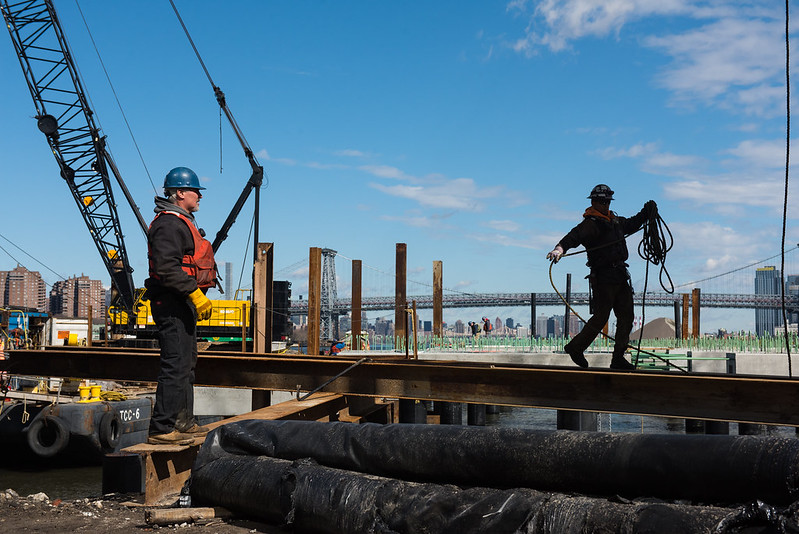
Construction workers (photo: Edwin J. Torres/Mayor's Office)
Labor statistics can be very confusing, especially for the general public.
The Bureau of Labor Statistics (BLS) just released its June 2020 report, and while it does show an uptick in employment across the nation, economic pain remains widespread. The numbers for New York City and New York State, while they lag behind the national report, show more severe difficulties. A New York Times article described the stunning local catastrophe.
Unemployment Stats - Who's In, Who's Out
Writing about the Bureau of Labor Statistics May 2020 employment report, I discussed the fact that more than 6 million persons had dropped out of the labor force between February and May 2020 and were no longer counted in the unemployment rate released that month.
Believe it or not, these labor force dropouts are not counted as unemployed.
It is the "civilian noninstitutional population 16 and over" who are working or looking for work who are counted as the labor force, and the percentage of those working or looking for work are calculated as the "labor force participation rate" out of the total civilian noninstitutional population over 16.
But those who have just dropped out of the labor force are human beings, not statistics, and are part of the overall human damage of the current covid recession and labor market concerns in general.
The U.S. June Employment Report
In the just released BLS June 2020 report the updated number for those who have dropped out of the labor force since February is 4.6 million. About 1.7 million persons re-entered the labor force in June, with presumably most regaining employment. Here is the table showing the data from the BLS June employment report for the size of the labor force and the participation rate:

Overall, the BLS reported for June that payroll employment rose by 4.8 million from May and the unemployment rate dropped to 11.1% from 13.3%. It showed a partial resumption of economic activity since the pandemic-induced major job shutdown in March and April that cut 22.2 million American jobs; 2.7 million jobs had been regained in May. The table shows the labor force was 164.5 million in February 2020 and 159.9 million in June 2020.
But now, Coronavirus Surges in Parts of the U.S.
While the gain was good news, the data were collected in mid-June and since then the explosion in coronavirus cases in the South and West has led to curtailment of economic activity in some states, including the three largest states: California, Texas, and Florida, and seems likely to limit near-term recovery of the economy. And, of course, nearly 15 million of the 22 million Americans who have lost their jobs since February are still unemployed.
New York City and State
Comparable data on labor force dropouts are available for New York City and State along with the general employment reports. The overall unemployment rates for New York City and New York State for May (state-by-state reports lag behind the national report) taken from the New York State Labor Department (whose data come from BLS) were as follows:

NYS and NYC Lost Jobs
New York State lost nearly 1.7 million jobs, and New York City about 890,000 jobs, respectively, between February and May 2020, according to data from State Labor Department releases that use the BLS reports (these data are not seasonally adjusted). These are payroll jobs, which include out-of-state residents, and represent different numbers than household employment data, which also include the self-employed. Here are the New York payroll reports:
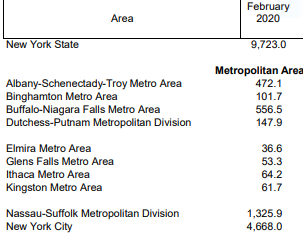

Unemployment rates are calculated from the Household data, which also show the size of the labor force on a monthly basis and the dropouts can be calculated from this data -- they move over to the category of not in the labor force and are not included in the unemployment rates.
Adding Labor "Dropouts" to New York City Stats Reveals a Real Unemployment Rate That Could be as High as 25%
Bureau of Labor Statistics data show that 462,000 persons dropped out of the labor force in New York State between February and May 2020, from 9.551 million to 9.089 million. In New York City, 381,000 persons dropped out of the labor force during this period, with the force dropping from 4.051 million to 3.670 million persons. Here are the data, taken from BLS state employment situation reports:

![]()

![]()
If the size of the labor force in New York City was still the same number of people as in February, 4.05 million, but the number of persons who have dropped out since that time (381,000) were added to the number unemployed in May, 671,000, the number unemployed would be 1.05 million out of what would be 4.05 million people in the labor force. That would bring the unemployment rate to just over 25% in New York City.
No Matter How You Calculate It, the Pandemic's Effect on the City's Employment is Staggering
Of course the real number wouldn't be that high because some of the dropouts might have decided to retire, or no longer be seeking work for some noneconomic reason like taking care of family. But the point is that the number of New York City residents who are out of the labor force since February, related to the pandemic, is immense.
In May 2020 the number of persons who dropped out of the labor force from February at the national level was 6.3 million; in New York City, the number was 381,000, or about 6% of the total number of labor force dropouts across the country, more than double the city's share of the nation's population, which is 2.5%.
Don't Expect a Quick Recovery in the City
The next state-by-state employment situation from the Bureau of Labor Statistics will be released on July 17. At the national level, about one-third of the persons who had dropped out of the labor force through May returned to the labor force by mid-June. New York State permitted all the regions of the state except New York City to expand their economic activity to a Phase III level pursuant to state guidelines, while New York City was allowed to reach Phase II level. The BLS is likely to have recorded some of this increase in economic activity in New York and our hard-hit state may show some meaningful improvement. But it's within the context of the severe damage to the economy, and predictions of economic recovery are far in the future.
***
Jim Brennan was a member of the New York State Assembly for 32 years, where he chaired four committees. On Twitter @JimBrennanNY.
***
Have an op-ed idea or submission for Gotham Gazette? Email This email address is being protected from spambots. You need JavaScript enabled to view it.
We Were Proud to Vote for Police Reforms, Now It’s Time for Prison Reform
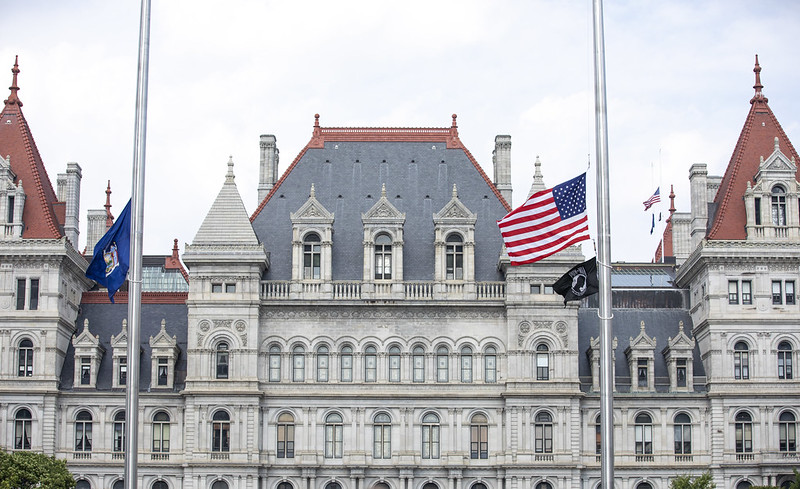
The State Capitol Building (photo: Governor's Office)
The murders of George Floyd, Breonna Taylor, and other Black people at the hands of police sparked righteous calls for change across New York State and led to meaningful action in Albany. We were proud to vote for police reforms that promote more transparency, accountability, and justice for those we represent. These were important steps, but they fall short of addressing the harm that happens to our constituents behind bars.
For years, we’ve spoken with mothers, children, and other people in our communities whose loved ones have suffered while incarcerated in our state prisons. This harm is often fatal and happens out of the view of cellphone cameras. Unsurprisingly, people of color disproportionately experience this harm.
Black and Latino people make up 34% of all New York State residents but represent 72% of the state’s incarcerated population. Amidst COVID-19, 80% of people who died in the custody of our state prisons were people of color -- 60% were Black people. Many of these people were older and posed no risk to public safety.
Black people and other people of color are disproportionately serving longer prison sentences and given fewer opportunities for release than their white counterparts. In New York State in particular, years of investigations have exposed that the State Parole Board disproportionately denies parole release to Black people, even when compared to their white counterparts with similar convictions and institutional records.
There are also roughly 1,000 New Yorkers serving prison sentences that don’t even allow a chance at release or public safety assessment. These cruel and unusual punishments amount to New York’s new form of capital punishment: death by incarceration. Curbing state violence on the streets does not address the full spectrum of harm if we continue systematically sentencing mostly Black and Latino people to die in prison without any meaningful second chance, exemplified by the tragic cases of Valerie Gaiter, Benjamin Smalls, and so many others.
People can be held accountable without being sentenced to die in prison. Victims and survivors can find healing without the person or people who harmed them facing a lifetime of punishment and torture. New York can promote safety and decarceration at the same time. We are ready to address these forms of state violence by passing two bills this state legislative session: our Elder Parole Act and the Fair and Timely Parole Act.
Elder Parole would allow the Parole Board to individually assess incarcerated people for a chance at release once they’ve served 15 more or years and are aged 55 or older. The bill would effectively end prison death sentences in New York State and help us move beyond our shameful distinction of having one of the highest prison populations of people serving life sentences in the country.
Fair and Timely Parole is just as important. It would change the Parole Board’s culture of punishment and vengeful practice of blanket parole denials by ensuring that parole release decisions are based on who people are today, instead of just on the nature of their crime. If at least part of the purported purpose of incarceration is rehabilitation, then the Parole Board’s decisions must be guided by people’s change over time.
These two bills, which align with decades of criminal justice research and public safety data, would allow us to reinvest resources, and would bring families back together. In this particular moment, they would also bring us steps forward in our lifelong battle to end structural racism and state violence.
***
Carmen De La Rosa is a New York State Assembly Member representing parts of Manhattan and the lead sponsor of Elder Parole (A.9040). Gustavo Rivera is a New York State Senator representing parts of the Bronx and is the lead sponsor of the Fair and Timely Parole Act (S.497A). On Twitter @CnDelarosa & @NYSenatorRivera.
***
Have an op-ed idea or submission for Gotham Gazette? Email This email address is being protected from spambots. You need JavaScript enabled to view it.
New York City Needs a Chief Diversity Officer Now
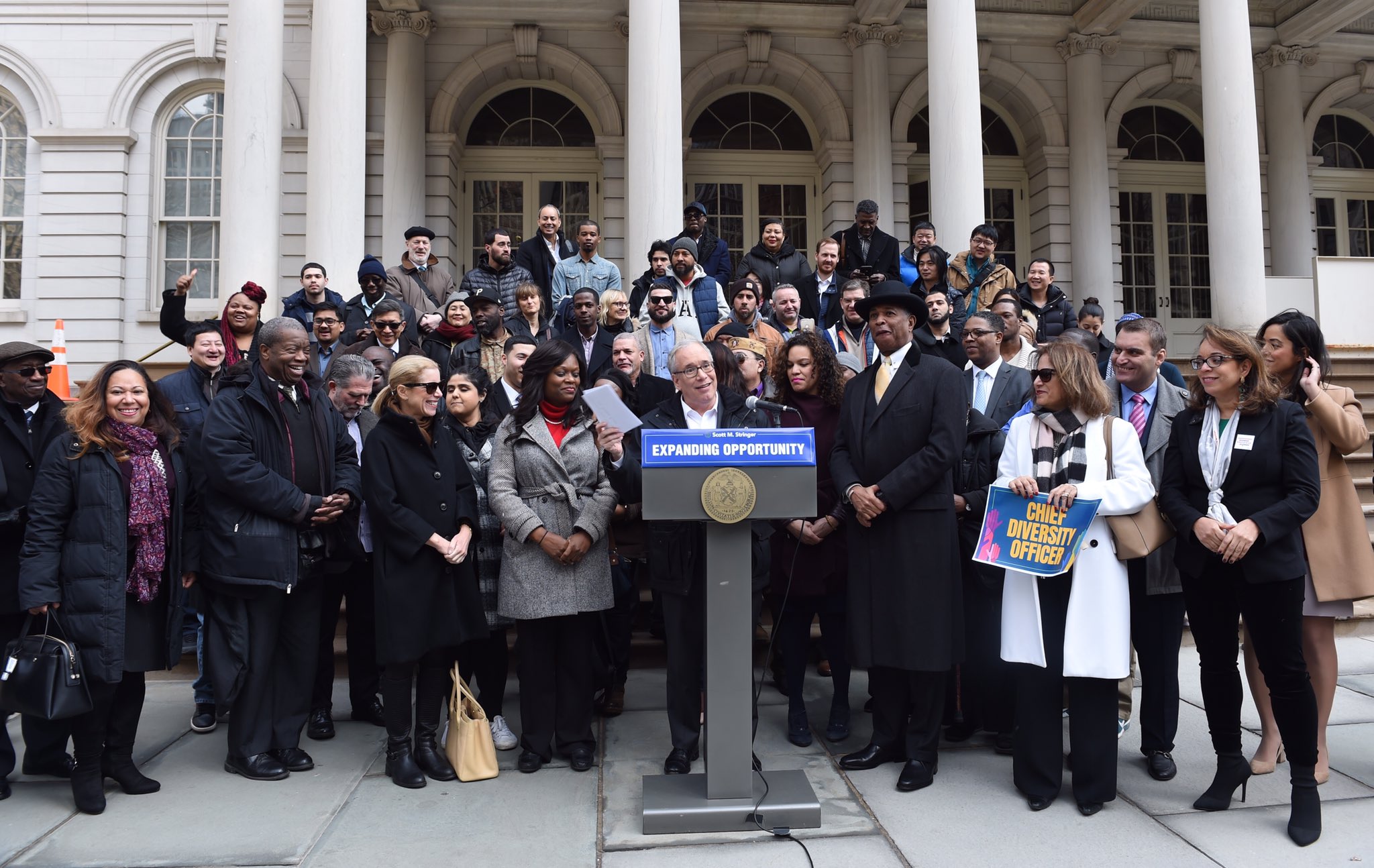
Comptroller Scott Stringer, the author, calling for a CDO (photo: Comptroller's Office)
The murders of George Floyd, Breonna Taylor, and Ahmaud Arbery catalyzed one of the largest social justice movements in United States history, rightfully forcing both the public and private sectors to finally listen to Black lives who have sounded the alarm for decades. Under heightened scrutiny, many corporations have taken preliminary steps to acknowledge and confront the systemic racism ingrained within their organizations – cognizant that to ignore the deafening cries for justice is a tacit admission of complicity that can have major consequences for bottom lines.
Whatever their motives, major players like Wells Fargo, Morgan Stanley, Korn Ferry, and Zoom have made the decision to hire Chief Diversity Officers (CDOs) who can serve as bridges between stated good intentions and reality. When utilized effectively, CDOs identify both overt and covert racism across the spectrum of workplace policy – hiring, retention, culture, management, and more – and implement strategies to course-correct.
It’s time for the public sector to do the same. I created a CDO position within the office of the New York City Comptroller when I took office in 2014, and the role has become an essential function of our office. Our CDO serves as an invaluable resource to New York City’s minority- and women-owned business enterprises (M/WBEs) navigating the labyrinth of city contracting and, most recently, the ongoing economic fallout of the COVID-19 pandemic.
With a CDO in place, we’ve increased diversity among the firms managing more than $205 billion in city pension assets, and we’ve launched successful initiatives to increase transparency and accountability in corporate America’s hiring practices. In recent weeks, our CDO has guided important officewide conversations as we work toward inclusivity, equity, and representation in all areas of our work. As a white, cis-gender male elected official, it’s my responsibility to create space, listen, and make sure that we’re walking the walk – and to commit to doing better when we fall short. We could not do this without our CDO keeping us on track.
Seeing firsthand the impact this position can create in a public office, I’ve urged New York City to embrace the role of a CDO to address the systemic racism that we know exists in all government institutions at every level. Last year, I joined a broad coalition of civic and faith leaders and owners of M/WBEs calling on the City Charter Revision Commission to install a CDO in City Hall, reporting directly to the Mayor, and one within every city agency.
A CDO for New York City would function as city government’s executive level diversity and inclusion strategist, driving the representation of people of color and women across government, tracking and overseeing the city’s M/WBE programs, and determining whether agencies’ daily practices are equitable. A citywide CDO could begin to tackle long-standing disparities that are now coming into stark relief -- from analyzing how taxpayer dollars are spent through an intersectional lens to removing barriers to doing business with the city to making sure public service is a viable option for people from diverse backgrounds and experiences.
That charter revision proposal did not make it onto the ballot – but the need for CDOs in government is now more apparent than ever and it’s not too late to act.
New York City agencies spend almost $20 billion a year on everything from pens and paper to consulting services and construction, yet less than 5 percent of those contracts are awarded to M/WBEs. In my most recent Making the Grade report, which grades city agencies on their spending with M/WBEs, the city earned a “C” grade with Hispanic-American-owned businesses, a “D” grade with women-owned businesses, and a dismal “F” grade with African-American-owned businesses.
Eighty percent of New Yorkers are either women or people of color and more than 600 languages are spoken on our streets; we cannot settle for an exclusionary status quo. A CDO could help break down the biases baked into our contracting processes, and make sure our spending represents the diversity of our city, its economy and its people.
We don’t need to wait for another Charter Revision Commission – the mayor can take administrative action right now to create Chief Diversity Officer roles within City Hall and across agencies. While the private sector has recognized the value empowered CDOs bring to institutions, local government continues to be years late and many billions of dollars short. We should not fall further behind. As we work toward a more just New York City, we need Chief Diversity Officers to help lead the way.
***
Scott Stringer is New York City Comptroller. On Twitter @NYCComptroller.
***
Have an op-ed idea or submission for Gotham Gazette? Email This email address is being protected from spambots. You need JavaScript enabled to view it.
Governor Cuomo: Stop Scapegoating Nursing Home Workers and Making Excuses for Your Deadly Decisions
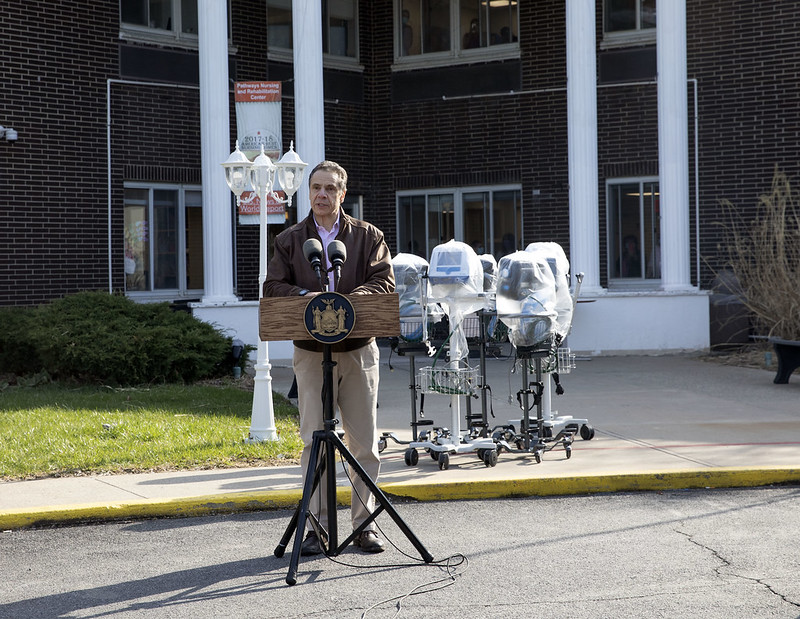
Governor Cuomo outside a nursing home (photo: Mike Groll/Governor's Office)
After Governor Cuomo forced nursing homes to admit COVID-positive patients, more than 6,300 aging New Yorkers died in those homes throughout the state. The state’s order required nursing home workers to care for patients in dangerous, inhumane, and sometimes deadly conditions, without adequate protections, including personal protective equipment.
Yet this week the governor again blamed nursing home workers for the state’s nursing home deaths — pointing the finger at staff who were working in life-threatening conditions. Instead of scapegoating staff, the governor should take responsibility for his deadly nursing home mandate, and start putting New York’s elderly population and care workers first.
On March 28, as coronavirus cases were spiking across the state, Governor Cuomo’s health department issued a mandate requiring nursing homes to accept patients with the novel coronavirus. The results were inevitably deadly: well over six thousand deaths from the virus. And this wasn’t the first time the governor put elderly New Yorkers and their families in harm’s way during the pandemic.
During this year’s budget negotiations, Governor Cuomo also slipped language into a bill providing immunity to nursing home executives. The Greater New York Hospital Association, which donated $2.3 million to Cuomo’s re-election campaign, literally wrote the budget language.
Cuomo has served as governor for more than nine years. During that time, he has allowed the nursing home industry to flout regulations. This failure during his long tenure turned nursing homes into unregulated pandemic graveyards waiting to happen. Yet when asked who holds blame for nursing home deaths, the governor pointed the finger at overworked and unprotected nursing home workers.
The majority of nursing home staff are people of color. During COVID-19, they’ve often not been provided with PPE. Poverty wages regularly force nursing home workers to work in more than one nursing home, without the ability to take sick leave. Blaming nursing home workers for the spread of the coronavirus, instead of blaming the state’s dangerous policies, threadbare regulations, and inadequate PPE, is cruel and irresponsible.
New York also has the highest racial disparity of COVID-19 cases in nursing homes of any state in the country. Eighty-four percent of New York nursing homes where at least a quarter of the residents were Black or Latino had COVID-19 cases. By comparison, just 33% of homes where the population was less than 5% Black and Latino had COVID-19 cases. Simply put, residents of color have been far more likely to live in a nursing home with COVID-19.
It’s clear the state has failed to prioritize nursing home workers and New York’s seniors — and particularly workers and seniors of color. Rather than continue to deflect blame, the governor should invest deeply in universal, dignified long-term care for all New Yorkers. The state needs to invest more funding into home-care services for better conditions for workers and to allow elders to remain home where possible with supporting family caregivers.
New York’s aging adults and people of color are not disposable. And nine-and-a-half years into his tenure, Governor Cuomo knows what he’s doing. When the governor lets thousands of nursing home workers and residents die, then blames them for their own deaths instead of taking responsibility, he knows he’s deflecting blame. It’s time for the governor to accept responsibility — both for his deadly nursing home mandate, and for the well-being of New York’s vulnerable seniors and nursing home workers.
***
Bobbie Sackman is a steering committee member of the New York Caring Majority, a statewide coalition of New York seniors, people with disabilities, and care workers.
***
Have an op-ed idea or submission for Gotham Gazette? Email This email address is being protected from spambots. You need JavaScript enabled to view it.
Getting New York City's Events Industry Up and Running Again
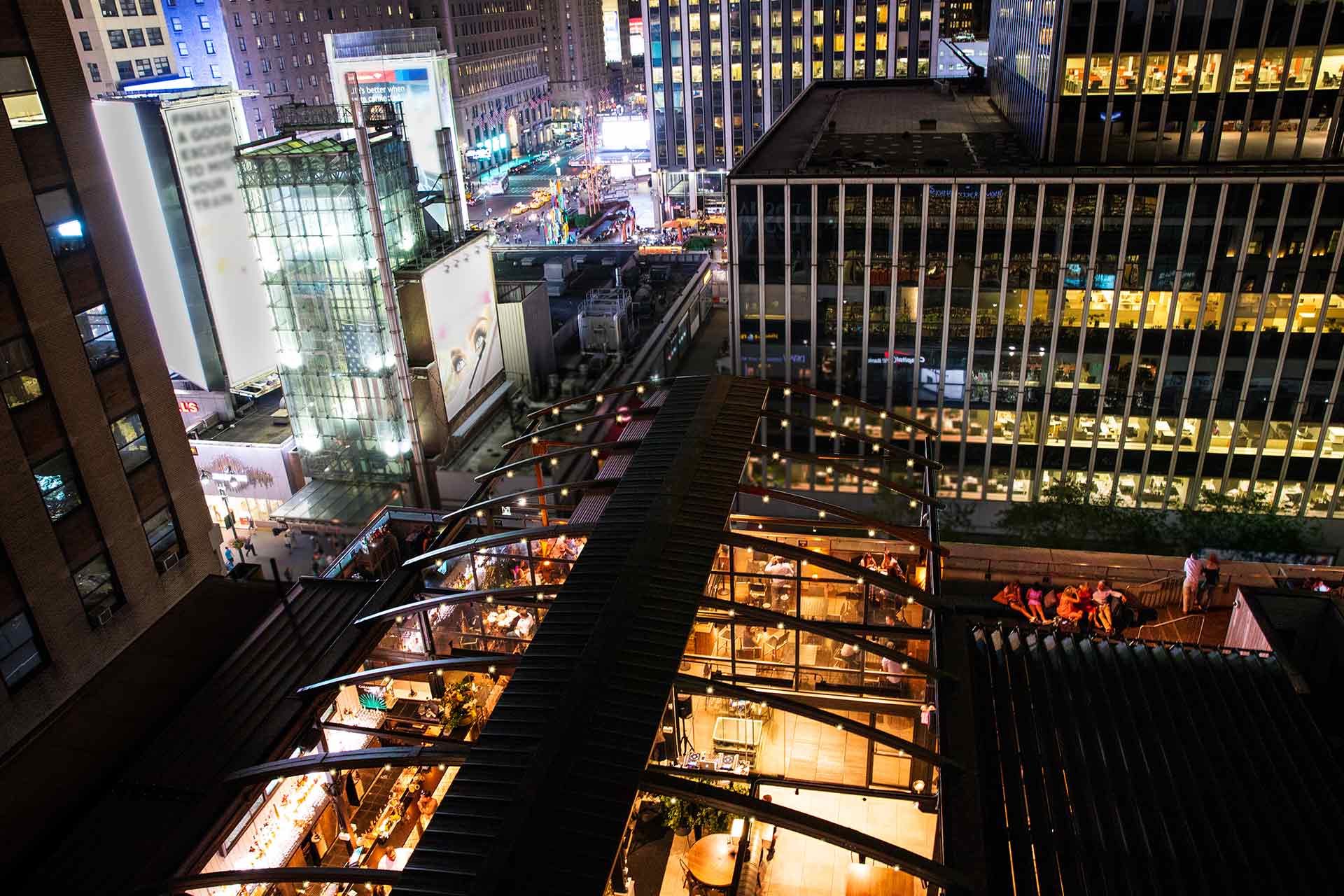
When can event spaces come back in New York City? (photo: VERSA)
The future is coming into focus. New York City is starting to reopen, and officials are releasing specific guidelines on how different industries can get back up and running, such as regulations for outdoor dining. Empty middle seats and temperature checks are clearly in the future for airlines.
But what about the events industry, which brings in $10 billion and employs approximately 500,000 in the State of New York? As CEO of the Backal Hospitality Group, I’ve seen first-hand how the events industry in New York City has been utterly flattened by the coronavirus. While restaurants have been able to pivot to offer takeout, curbside pickup, or delivery when New York first went on “pause,” and airlines are still able to fly throughout the past few months, the events industry has come to a complete halt, the hardest hit among businesses based on the idea of bringing groups of people together.
With all the daily announcements from Albany, it is still unclear which of the four reopening phases will allow events to restart.
Backal Hospitality Group employs up to 200 individuals and creates corporate events, fundraising galas for not-for-profits, and social gatherings. We cannot fall between the cracks (or phases). The many thousands who count on the events industry for their incomes are eager to get back to work and want to do so safely. How do we rebuild?
Following the recommended guidelines for health and safety protocols from officials, those of us in the industry need to be proactive, creative, and aggressive in coming up with solutions ourselves; ideas that will preserve the appeal of what we offer while making customers feel safe because they are safe. It might seem like an impossible task, but it’s not.
First, we will have to accept that our events may look different in the beginning. We must adapt, even if it brings some temporary financial pain. For a time, our profit margins will be stretched if not eliminated, but at least we will be doing any business at all. We must recognize we are in this for the long run, and we will have to rebuild step by step slowly and steadily to get where we need to go and preserve our industry that employs everyone from independent florists to caterers to local entertainment to photographers and many more.
If we smartly implement health and safety protocols for all events, which go hand-in-hand with the goals of elected officials, then we may avoid having our industry on hold for months longer, which would be devastating to the livelihood of thousands of New Yorkers.
Here are some ideas:
Governor Cuomo has allowed groups of 25 to gather. It’s more than the original groups of 10 he authorized, but, since this still isn’t much of an event in terms of our industry, why not several groups of 25 in smaller, separated rooms? Would that be the basis for a socially-distanced evening or lunch?
In New Jersey and Connecticut, both governors are allowing larger groups, including Gov. Ned Lamont of Connecticut who may permit groups up to 250 by mid-July with social distancing protocols still in place. As Governor Cuomo has said before, I think the region should be unified on such regulations.
Could guests be brought into an event on a staggered and reserved timeline, cycling through and with thorough cleanings in between each group, so that the overall group never gets too large?
What is safer – sit-down dining or pass-around appetizers? And why not use one of the more elegant and simple dining systems ever conceived: the Bento box? These could contain multiple items for a single guest, and no passing them around. And they can be made quite beautifully.
All servers will of course wear masks and gloves. A few months ago, this might have seemed strange, even alarming, but this is our new normal for the health and safety of all of us.
Then there is the great outdoors. Let’s take a cue from the restaurant industry.
Perhaps, before the pandemic, you had an opportunity to gaze down at the rooftops of Manhattan from a skyscraper. That landscape has changed incredibly in recent years. What was once a sea of black tar and AC units is now filled with gardens and decks and cabanas. Rooftop bars and restaurants abound, and there is a great deal of opportunity.
A few years ago I became a managing partner and operator at VERSA Restaurant and Rooftop, which has an 8,000 square-foot outdoor area located in the Renaissance New York Midtown Hotel. It’s been closed for over three months. Summer is upon us. If the city and state have approved outdoor dining rules, they should apply to outdoor event spaces, too. We have the room to socially-distance our tables, and then some.
And we have a far better view than you do from the street.
***
Arthur Backal is CEO of Backal Hospitality Group.
***
Have an op-ed idea or submission for Gotham Gazette? Email This email address is being protected from spambots. You need JavaScript enabled to view it.
Cash Homebuyers Threaten Covid Recovery and Deepen Racial Wealth Gap
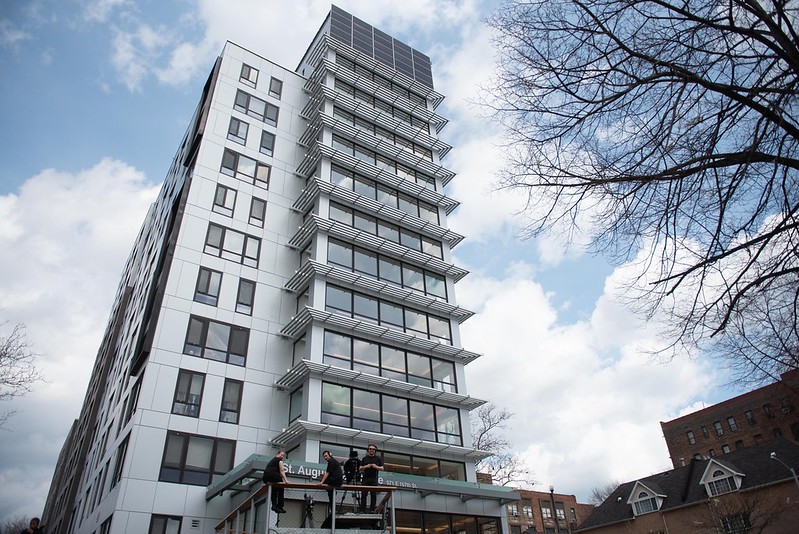
Photo
An astonishing 11.3% of New York mortgage borrowers are behind on their mortgage, a 121% increase over the same time last year. That figure only hints at the economic pain being felt in New York and across the country, and pain that is being temporarily moderated by stopgap measures like forbearance plans and unemployment insurance, but threatens to bubble over into a full-blown housing crisis.
In just two months, the federal foreclosure moratorium will expire and the government still has not adopted measures for a post-COVID housing market, especially not for low-income and Black and brown communities. If we’ve learned anything from the Great Recession, cash wielding, predatory investors thrive amidst a disrupted housing market, taking advantage of dropping prices and foreclosure sales, which will further disadvantage aspiring homeowners.
In a recently released analysis, “The Outsized Power of Cash Buyers in New York City’s Housing Market,” the Center for NYC Neighborhoods found that over 40% of small home, co-op, and condo sales in the Big Apple have been to cash buyers over the past ten years, even though 80% of homebuyers take out a mortgage nationally. Investors are targeting the modestly priced co-ops and single-family homes in neighborhoods where working class families have traditionally been able to buy.
Competition from cash buyers was already a leading obstacle to homeownership in New York City and COVID-19 threatens to compound the problem. Even with interest rates low, widespread loss of income will make it difficult for renters to qualify for mortgages at the city’s high price points. Meanwhile, lenders are tightening access to mortgages by increasing down payment requirements and minimum credit scores, leading the Mortgage Bankers Association to drop its Credit Availability Index to its lowest point since 2014.
By definition, cash buyers don’t need mortgages, leaving them in prime position to take advantage of the post-COVID economy. When forbearance periods end, we anticipate a surge of homeowner distress that will yield thousands of foreclosures. Cash buyers will be ready to target these properties with expertise built after the Great Recession and pockets full from investors looking to move their money out of COVID-gutted industries like restaurants and airlines and into the relative safety of New York City real estate.
A replay of the Great Recession would not only shrink the city’s already small homeownership landscape but deepen the racial wealth gap that is driven by uneven access to homeownership for Black and Latino households. In an early June survey, the Census Bureau found that while 11% of white homeowners had not been able to make their previous month’s mortgage payment, that was true for 17% of Latino homeowners and 35% of Black homeowners in New York. Factoring in racial disparities in access to mortgage refinancing, it’s hard not to conclude that COVID threatens to devastate the assets of families of color at a time when the need for racial justice has never been more glaring.
Local governments can take important steps to ensure that speculative cash buyers aren't the only player in the post-COVID housing market. A tenant opportunity to purchase, like the laws in Washington DC and San Francisco, would empower renters to buy their buildings off of bankrupt landlords, creating new ownership where it would otherwise be neglected. A reform of the inequitable Mortgage Recording Tax and a boost to City and State down-payment assistance – a key plank of many reparations proposals – would help elevate first-time homebuyers over the competition coming from predatory investors. And the State can go further by preventing distress in the first place: funding foreclosure prevention services and rent relief – absolute necessities given the coming demand.
The cost of inaction is, to put it simply, devastating to our neighborhoods and to the New York state economy. We have been here before so we have no excuse to be caught off-guard by cash buyers and distressed property investors. State government must stop stalling on addressing homeownership protections post-COVID and press forward with bold measures to keep families in their homes as they try to get back on their feet during what looks like a long recovery ahead.
***
Leo Goldberg is Policy Manager at Center for NYC Neighborhoods. On Twitter @CNYCN.
***
Have an op-ed idea or submission for Gotham Gazette? Email This email address is being protected from spambots. You need JavaScript enabled to view it.
New York Got Federal Money to Address Extreme Heat; Now’s The Time To Use It
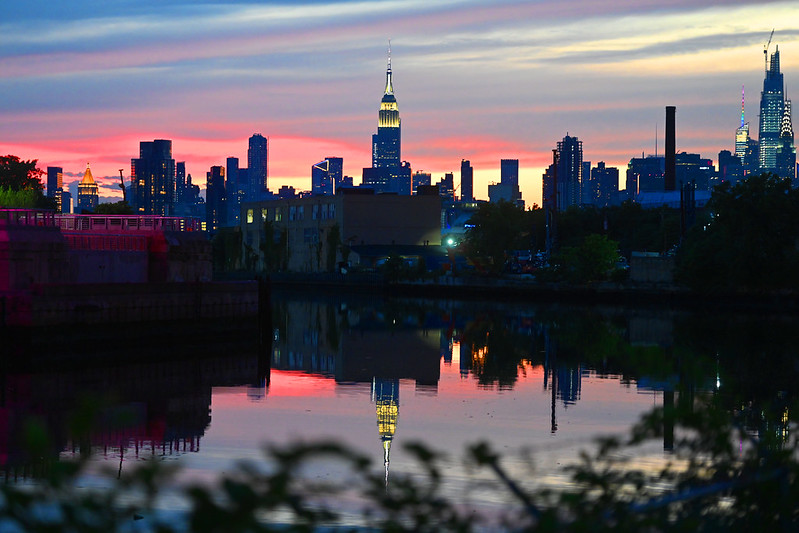
Summer heat has arrived (photo: governor's office)
The sudden spread of COVID-19 caught governments around the world off-guard, setting off one of the deadliest public health crises in generations. We are learning many lessons from this pandemic, including the importance of preparing for emergencies early and taking decisive action when they strike, especially in New York State, the epicenter of the crisis, where there are over 380,000 confirmed cases and more than 24,000 deaths.
With summer officially beginning on June 20, another public health crisis is hiding in plain sight: extreme heat. It is our duty to sound the alarm when our constituents are facing danger, and that moment is now.
Extreme heat is the deadliest of all natural disasters in our state, killing an average of 130 people every year in New York City alone. With climate change fueling hotter, longer heatwaves, and COVID-19 forcing New Yorkers to spend more time in their homes and apartments, this year is poised to be much more dangerous.
At highest risk are our Black and brown communities – the same ones that have already suffered the most from the novel coronavirus, and which continue to experience tragic police brutality, rampant discrimination, and the many other effects of systemic racism. All of these issues have one thing in common: the stakes are literally life and death.
In these communities that are already hurting so badly, thousands of families don’t have an air conditioner. Many more can’t afford to run the one they have. As unemployment skyrockets, New Yorkers across the state will be forced into the completely unacceptable choice between putting food on the table and switching on the A/C unit that could save their lives.
We cannot allow that to happen.
Many of the places that New Yorkers traditionally visit to beat the heat—such as pools, movie theaters, and cooling centers—could be closed for large parts of the summer. For this reason, we need to bring a fresh approach to keeping New Yorkers safe and cool by focusing on homes and apartments.
New York City Mayor Bill de Blasio recently took a necessary step by dedicating $55 million to provide air conditioning units to 74,000 elderly and low-income New Yorkers.
Now it’s time for Governor Andrew Cuomo to do his part to help New Yorkers stay cool in New York City and across the state.
Currently, New York State allocates just $6 million per year for in-home cooling assistance though the Home Energy Assistance Program, or HEAP.
HEAP funds are disbursed on a first-come-first-serve basis, meaning that many households that need help will get turned away if available funding doesn’t meet the scope of the need.
But importantly, as part of the federal CARES Act, Congress recently allocated $28.8 million to New York State in additional HEAP funding. These funds should immediately be allocated to address cooling support this summer for our vulnerable residents.
Governor Cuomo should simultaneously reform the state’s HEAP program, managed by the Office of Temporary and Disability Assistance (OTDA), to ensure this desperately needed financial aid reaches those who need it most.
First, the Governor should expand program eligibility to include NYCHA and Section 8 residents, historically barred from the program. He should also simplify medical documentation requirements to ease the burden on our health-care system. Finally, he should expand HEAP to go beyond providing A/C units by authorizing cash grants to help households pay their higher summertime electricity bills.
These important reforms can all be accomplished by executive order. The time to act is now – lives depend on it.
***
State Senator Gustavo Rivera represents parts of the Bronx. Assemblymember Andrew Hevesi represents parts of Queens. On Twitter @NYSenatorRivera & @AndrewHevesi.
***
Have an op-ed idea or submission for Gotham Gazette? Email This email address is being protected from spambots. You need JavaScript enabled to view it.
Deconstructing the #DefundNYPD Clash with City Council Members of Color
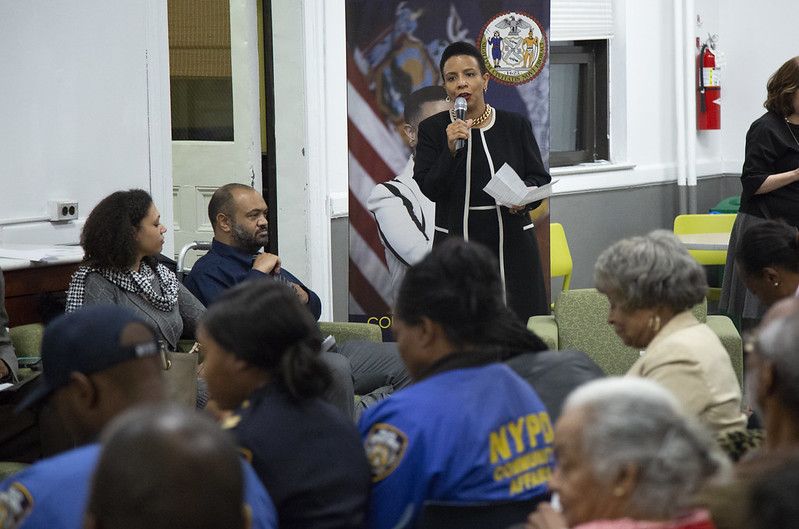
Council Member Cumbo (photo: John McCarten/City Council)
Defending her vote in support of a new city budget that did not cut NYPD funding by at least $1 billion (as New York City faces a $10 billion COVID-19-related revenue shortfall) Brooklyn City Council Member Laurie Cumbo told protesters criticizing the plan: "Work under the existing leadership of the communities that are already there."
Cumbo compared the development of the #DefundNYPD movement to "colonization" and said, "this movement is not being led by the Black community."
She and several other Council members of color made it sound like protests against state violence and inequality in city resource allocation had come out of nowhere from parts unknown. Did the few Black and Latino Council members who voted against the budget over lack of NYPD cuts blindly follow a movement of outsiders? Cumbo’s former chief of operations quickly rejected Cumbo’s narrative.
In a late-night tweetstorm Crystal Hudson listed 10 leading Black organizers, whose groups are among the over 170 organizations pushing to #DefundNYPD that Cumbo and other members have no doubt encountered during their time in the Council. The movement against state violence has been and is today led by marginalized peoples, Black women, Latino, Asian, immigrant, and LGBTQ.
Yes, there are many new people engaging in local politics, some are new residents in communities facing gentrification, and some of them eyeing elected seats in districts they recently moved to (an article for another day). But the vast majority of #DefundNYPD activists are simply people fighting to divest from policing and incarceration and to reinvest that money in those who most need it. And though Council members resent being the subjects of criticism and desperate pleas to do more, as the old saying goes, “It’s not about you.”
Many New York City Council members of color say that in their communities people aren't screaming for police defunding or abolition. One wonders, did they just close their windows each time a #BlackLivesMatter protest marched by their house? It is true that this year’s #BlackLivesMatter protests have engaged far more white people than they did when Eric Garner was killed, but in response to those protests the Council voted through a budget that added 1,300 new police officers. What Black or Latino Council member can honestly say their communities were screaming “Build new jails!“ when they approved billions to do just that in 2019? (None.)
Though to Cumbo’s point, when Council members of color and NYPD Commissioner Dermot Shea claim the community is asking for more police, there is truth there. The question is, which community are they referring to? Common community venues politicians and police leaders tell protesters to get involved in include local meetings of Community Boards and Precinct Community Councils. While community boards are not uniform -- multiple CBs passed resolutions in support of #DefundNYPD, including East Harlem's CB11 calling to #DefundNYPD by at least $1B in FY21 -- they’re generally more police-friendly organizations than the broader neighborhoods they are part of.
Community Boards are appointed by the local Borough President and City Council member. Local electeds don't often choose a bunch of people who think far differently than they do. There’s no public reason given as to why one is or is not chosen to a community board and many appointees have existing relationships with local electeds. Members are often removed from community board committees or not reappointed to CBs for rocking the political boat. As all-volunteer entities chosen by politicos where dissenting voices are not always welcome, community boards are not often viewed as a functional space where meaningful change can happen or be pursued. Because New York City has a dearth of local civics education, most don’t even know that it is the first rung of city government, a feeder for elected office (several sitting Council members, including the Speaker, are former community board chairs and more are former CB members).
If you’ve ever gone to a community board meeting in a Black or Latino neighborhood you might feel like you stepped into a world where #BlackLivesMatter never happened. There isn’t a lot of reimagining public safety outside of police. Fear of returning to the "bad old days" of the 1970s and ‘80s reigns.
A return to the “bad old days” is the ultimate political boogeyman in New York City politics. It can quickly undermine substantive policy arguments in almost any public safety conversation. Of course, crime and cops not responding, were just part of planned disinvestment of the past. Many community board members in communities of color are old enough to have lived the last crisis even close to the one New York City now faces. They are reminded of the crime and divestment as they walk by firehouses and schools that have remained closed since their childhood or those recently converted to luxury developments.
Community boards trend older and more conservative. Property owners are overly represented, renters and the homeless under-represented. Black and Latino CB members often live in neighborhoods that face more police violence and gun violence than their white counterparts. Local police are accessible to and regularly engage with many community boards. When calls to reform or cut police come, community board members often think of the last shooting or the working relationships they have with officers who report to the community board and work community events.
At Precinct Community Council meetings in Black and Latino neighborhoods, you won't find many people who have been abused by or lost family members to police, virtually no one actively calling for reinvestment of NYPD funds into social services, and few immigrants. Why? Precinct Community Council meetings are held with many cops and most often in police precincts. Most of the agenda is dominated by Black and brown people literally begging the police to “deal with” homelessness, “deal with” substance abuse, “deal with” guys hanging out on the corner, and “deal with” the seven major crimes (murder, burglary, assault, car theft, and so on).
One can be from and "do the work" in Black and Latino neighborhoods in New York City and not spend a minute in politician- or cop-dominated/funded spaces (some would call this self-care).
Tons of longtime residents who do mutual aid, community, and anti-violence work -- who fight health disparities, hunger, gentrification, racism, homelessness, and deportations -- avoid Community Board and Precinct Community Council meetings like the plague.
#DefundNYPD was coming from all over Black and Latino neighborhoods in New York City. From non-profits getting their budgets cut, individuals losing their jobs, people facing eviction when the moratorium ends, the hungry, the homeless, families of those killed by police violence, and others.
This new city budget was always going to be lose-lose chaos. City Council members got the ball after Trump and the Feds refused to reimburse cities and states for COVID-19-caused revenue deficits. Cuomo cut Medicaid and wouldn't allow New York City to borrow money to fill the tax revenue gaps. Trump, Cuomo, and de Blasio all refused to raise taxes on the wealthy. De Blasio offered a tale of two cities budget that slashed education and hospitals while protecting police and the wealthiest.
Disparaging #DefundNYPD and using budgetary tricks to act like the city got far closer to (or over) $1 billion in NYPD cuts didn't fool a single person paying attention. People can read budgets (though no public copy of the full Fiscal Year 2021 budget was available before the Council vote) and see through the funny math the mayor and Council presented. To pretend NYPD cuts are more than reality just handed talking points to the right wing, who will now claim, as Trump and Staten Island Council Member Joseph Borelli already have, that crime is rising because of $1 billion or more in NYPD ‘cuts.’
Expecting that the NYPD face a substantial budget cut like virtually every other city agency during a depression is not "abolition." A substantial cut to the NYPD’s almost $6 billion budget was not radical. It should have been inevitable. It's what happens when tax revenue dips $10 billion, and no one can say how much deeper it will drop, or when or what recovery looks like.
The difficulty in making NYPD cuts comes not only from strong police unions, their military and surveillance capabilities, but the deep faith in policing that is still shared across the political aisle. For all of the social services the NYPD is involved in; there are people in and out of city government who for many years have called for cops to get more involved with them. People still call cops to "deal with" fireworks, kids smoking weed, and loud music. On an individual and structural level, we call cops like genies in a bottle then wonder why we can't hold police accountable or their budget in check, why police “reform” never gets at the root.
Investing in jails and police while cutting education and public health has never made our communities safer. As Ruth Wilson Gilmore explained when talking with the New York Times last year, abolition of police is not the absence of "safety.” Abolition is not just closing prisons and dismantling the police; it is creating and maintaining vital systems of support many of our communities lack.
At a local level, New Yorkers have stepped up for each other through the most heartbreaking of challenges. But at federal, state, and municipal levels we have not addressed the root causes of any of our compounding pandemics or their impact on mental health (see New Orleans after Katrina [1] [2]). Crime will almost certainly continue to rise in the coming months, and that is because of the existing racial and socioeconomic inequality COVID-19 has only exacerbated -- pre-existing conditions many elected officials still see as “fake” or too "unrealistic" to prioritize.
If those calling for defunding and abolition cannot effectively address the reasons people feel the need to call the police and cannot offer alternatives to calling police viewed as viable by those most impacted by non-police violence, then people will keep calling the cops, long past the next election.
If politicos in New York City’s Black and Latino neighborhoods don't open themselves to conversations on "public safety" not dominated by them or police and continue to dismiss calls to divest and abolish as stuff only people on Twitter and new residents to their districts who don't "do the work” care about, then they are making the political miscalculation of their lives.
***
Andrew J. Padilla, an award-winning artist and educator born and raised in East Harlem, has lectured on urban politics across the country, from Hostos to Harvard, and is a proud member of Manhattan Community Board 11. On Twitter @apadillafilm6.
***
Have an op-ed idea or submission for Gotham Gazette? Email This email address is being protected from spambots. You need JavaScript enabled to view it.
Governor, Legislature Must Take CUNY Cuts Off The Table
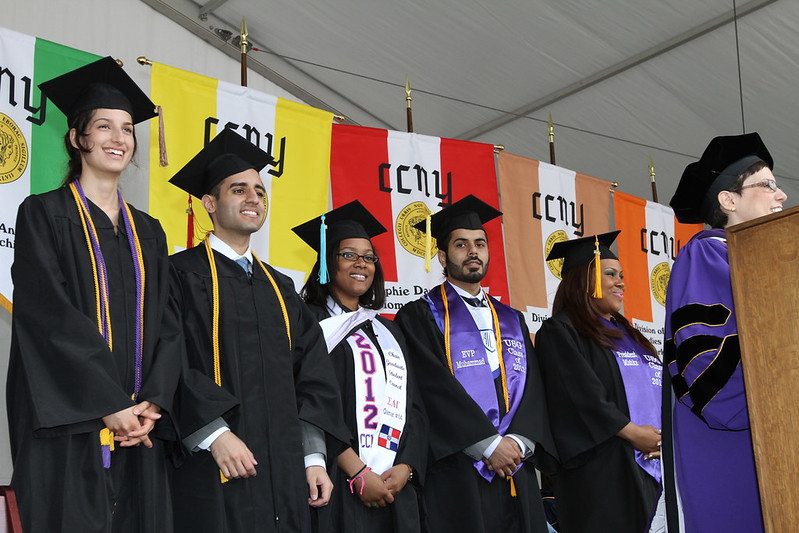
City College graduation of the past (photo: CUNY)
We cannot have a meaningful conversation about educational equity in New York City without calling attention to the deep funding cuts that the City University of New York (CUNY) is facing. For countless New Yorkers like myself, CUNY means access to an excellent public education and a path to career. Cutting CUNY resources flies in the face of the discussions we are having right now around racism, classism, and social justice.
Governor Andrew Cuomo and the State Legislature are weighing steep cuts to CUNY’s budget, and we need to be clear about exactly what those cuts would mean: reducing the quality of a public higher education system in New York that mainly serves historically-marginalized communities of color; 25% of CUNY undergraduate students identify as Black, 30% identify as Latino, and 60% receive Pell grant funding. Any discussion must meet the moment and be about what lawmakers can do to lift up institutions that serve all New Yorkers, particularly those that have educated thousands of young people of color for generations.
I know why CUNY means equity because I’ve lived it; I’m one of over 200,000 students of color who attend CUNY schools every year.
CUNY is led by Félix Matos Rodríguez, a champion for New York City college students and equity in education. He is well-known in the higher education community for his commitment to breaking down financial barriers for students from low-income backgrounds, as well as his appointments of senior leaders of color at CUNY. Under his leadership, many Black, Latino, and first-generation students have received life-changing educational opportunities and launching pads to careers of their choosing.
I personally wouldn’t have been able to graduate debt-free this spring if not for CUNY. My sister – who was the first in my family to go to college – went to City College and had an amazing experience, so I applied and received a scholarship. I was in good company at KIPP NYC College Prep High School in the Bronx, which sent 76 students to CUNY schools the year I graduated. In fact, since our high school started graduating students seven years ago, 40% of its student body has gone to CUNY.
At City College, I was a part of the media and communications program. Within my program, I learned the ins and outs of the advertising and public relations industry while also connecting and building relationships with my professors, who are professionals in the field. Through my program, I was able to find internships and stay on track with my career goals.
By cutting funds, CUNY students will not be afforded the opportunities I was given. During my time at City College, I was granted access to resources like the writing center, the career center, and amazing adjunct professors, who helped me navigate course and career decisions. Many CUNY students are first-generation college attendees; taking away these vital resources would stunt the trajectory from college to career, and beyond.
Cutting CUNY’s budget would hinder schools and the diverse student population they serve, plain and simple. I’m asking the governor and the Legislature to do the right thing and preserve funding for CUNY. Let’s move one step closer to creating the equitable New York we all deserve.
***
Miranda Genao graduated from The City College of New York in May 2020 with a degree in Media and Communications. She is a first-generation college student from the Bronx.
***
Have an op-ed idea or submission for Gotham Gazette? Email This email address is being protected from spambots. You need JavaScript enabled to view it.
Covid Laid Bare Systemic Disparities. Our City Must Make Bold Changes for an Equitable Recovery
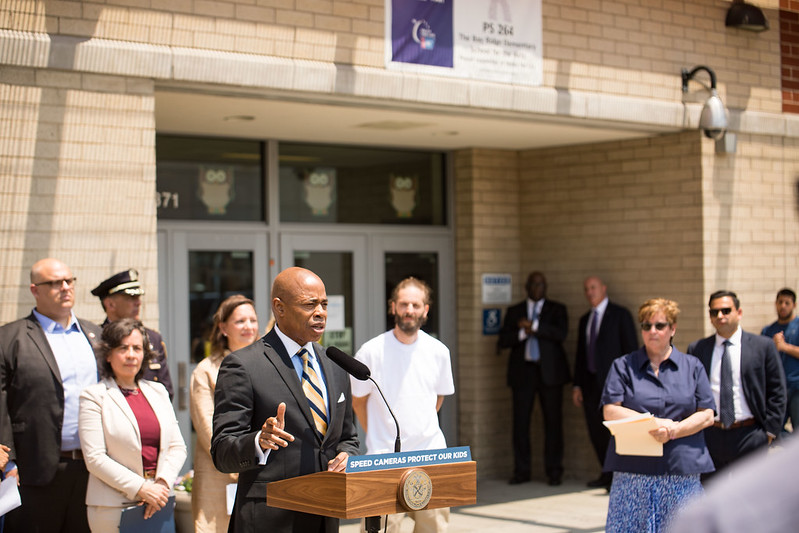
BK BP Eric Adams, the author (photo: Benjamin Kanter/Mayor's Office)
New Yorkers have spent most of 2020 enduring an unprecedented health crisis that threatens us physically and financially like never before. We are also experiencing historic social unrest. People of color are feeling all of that pain far worse than their white neighbors.
There is, however, nothing unprecedented or unusual about that.
Black and brown New Yorkers have suffered from deep health, financial, and criminal justice disparities throughout the history of our city. COVID-19 and the aftermath of George Floyd’s killing are just the latest chapters in a long, disgraceful story.
The difference today though is that the world beyond communities of color seems to be paying much more attention to these unforgivable inequities. So if there has ever been a moment for New York’s government and its priorities to fundamentally change, it is now.
Yet, with the New York City budget deadline looming, the proposals for “change” coming out of City Hall look distressingly similar to the status quo that brought us to this terrible place.
There is one exception: the City Council is pushing to move significant funding away from the NYPD toward programs that benefit Black and brown communities.
But, while I believe strongly it is necessary to reallocate those funds to improve policing and the communities police serve, I am disappointed that the police department budget seems to be the extent of the high-level debate at City Hall around how to address the myriad crises faced by people of color.
Overly aggressive policing is not the sum of the problem—it is a symptom of a much larger, endemic, historic issue. Black and brown people have not been prioritized by generations of mayors and City Councils. That inattention has led to racial inequities in our income and our health, as well as our treatment by law enforcement. And those inequities have led to horrible injustices.
You really just need to know two numbers to understand the level of injustice: White New Yorkers, on average, live four years longer and earn nearly twice as much as Black New Yorkers. The COVID-19 crisis is both demonstrating and exacerbating those inequalities as people of color die and lose their jobs at much higher rates. So what are we doing about that?
Instead of just drawing from reserves and moving a few numbers around to deal with a yawning deficit and then calling it a day, it is imperative that we directly address these massive inequality gaps. That means big changes.
I recently released a Real Recovery Plan for New York City. Here are a few examples of how I believe we can make real change right now:
Apply an inequality test. We must immediately institute an agency-by-agency Inequality Impact Test, prioritizing spending that has the best chance of reversing historic financial and health gaps.
Directly invest in people of color. Frontline workers–the majority of whom are people of color–should get more money back on their taxes, period. And those who are struggling with health issues should get a break when they participate in wellness programs. We must also bring the city to the community by opening up job-training storefronts and sending health workers into lower-income areas.
Support M/WBEs. Businesses hired by city government should be asked to commit to hiring 90 percent city-based workers, prioritizing minority- and women-owned business enterprises (M/WBEs), and ensuring their contractors pay a living wage and certain benefits. Employers who agree to these terms could benefit from tax breaks and special consideration for city contracts.
But how do we pay for a fairer city during a financial crisis? As the old saying goes, budgets are about priorities. It’s not just the police department budget that is bloated. And although all of the ideas in our Real Recovery Plan can be paid for with cost savings from the NYPD, we can also trim fat that has built up in other agencies. After all, the city budget has increased an extraordinary 27 percent since 2010.
We can also find money to reduce inequality with permanent changes to how the city does business. For instance, hundreds of highly paid political appointees fill positions in the mayor’s office, agencies, City Council–and, yes, the Borough Presidents’ offices–that are redundant. We also now know that thousands of city employees can work from home, making millions of square feet of office space unnecessary.
This is a pivotal moment. We can create a fairer future by finally addressing the sins of the past. To thrive, we cannot rearrange deck chairs on a sinking ship. We have to build a new boat—one that can carry every New Yorker above the rising tide.
***
Eric L. Adams is Brooklyn Borough President. On Twitter @BKBoroHall.
***
Have an op-ed idea or submission for Gotham Gazette? Email This email address is being protected from spambots. You need JavaScript enabled to view it.
New York Must Better Plan Decommissioning of Nuclear Power Plants; A Bill Awaiting Passage in Albany Does Just That
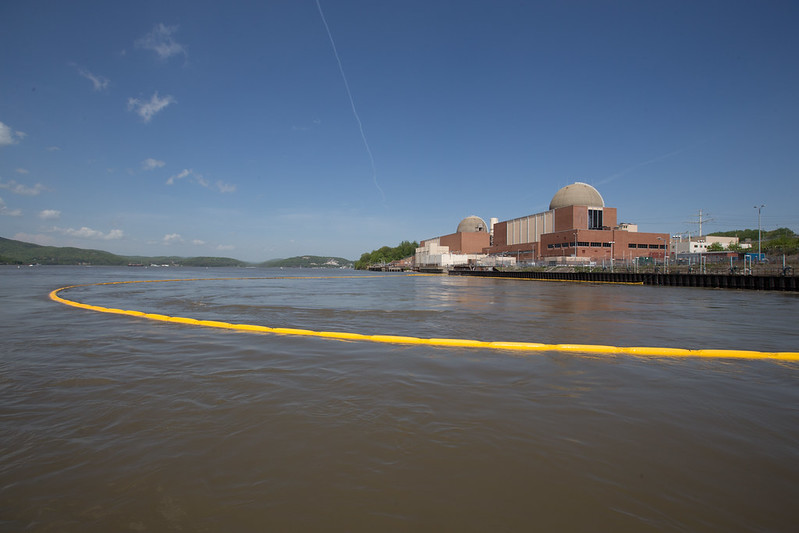
Indian Point nuclear power plant (photo: governor's office)
The 2020 session of the New York State Legislature has been another one for the record books, passing landmark legislation to address climate change, pandemic relief, and police reform. It’s a remarkable set of achievements, but the work of this legislative session isn’t complete yet, because there’s another pressing, high-stakes measure that can’t wait until next year: a pending bill to create a state oversight board on nuclear power plant decommissioning.
The decommissioning process entails breaking apart and shipping radioactive nuclear plant components, addressing radioactive site contamination, and managing, storing, and/or shipping highly radioactive spent fuel inventories. The spent fuel pools of Westchester’s Indian Point nuclear plant, 25 miles from Manhattan, contain about three times the radioactivity of the entire Fukushima complex in Japan, some of which is leaking into groundwater and the Hudson.
Decommissioning decisions have profound environmental, economic, and public health consequences, and they need appropriate regulation and oversight.
Decommissioning is getting underway in New York as Indian Point shuts down. One of its reactors powered down permanently in April, the other will close next April. Other plants in upstate New York will follow suit in the years ahead.
The pending bill in the Legislature (Senate 8154/Assembly 10236), would create the first-ever Nuclear Generating Station Decommissioning Oversight Board, to be composed of representatives from relevant state agencies, diverse stakeholders, and concerned citizens. It would oversee and monitor decommissioning decisions, and provide a channel for public input into how private companies conduct decommissioning work. If the bill is enacted, the Board would be the first of its kind in the United States, and could serve as a model for other states.
Despite the clear, vital interests state and local governments have in getting decommissioning right to protect New York’s health, safety, environment, and economy, until now the question of state authority over and input into decommissioning decisions has been murky and attenuated. The federal Nuclear Regulatory Commission (NRC) has jurisdiction over nuclear plant safety issues, but it is so close to the plant owners it is supposed to regulate (who not incidentally fund 90% of the agency’s budget) it calls them its “clients,” and is known as a prime example of “regulatory capture.” Its oversight of decommissioning has been extremely lax, riddled with waivers, exemptions, and rollbacks, essentially doing whatever the licensees want.
And the NRC hasn’t exactly welcomed input from state or local governments or other stakeholders that want better oversight. In fact, the NRC cut Massachusetts out of the approval process to transfer the licenses of the shuttered Pilgrim nuclear plant to a subsidiary of Holtec for decommissioning. Holtec’s business model is to leverage public money rather than bring any of its own to the table, and it has a big trustworthiness problem, including a long track record of bribery and fraud. Yet the NRC refused even to hold hearings on the Pilgrim license transfer where the state could air its concerns about Holtec.
So Massachusetts Attorney General Maura Healy sued the NRC, joined by 12 states including New York. In her filings she expressed skepticism about Holtec’s plan to “decommission Pilgrim on an expedited schedule never before achieved,” despite having never owned a nuclear plant nor managed a decommissioning start to finish. “Holtec’s attempt to account for contingencies and uncertainty risk is woefully deficient,” she said. She also warned Holtec might deplete the decommissioning trust fund, leaving “taxpayers to bear the financial burden and responsibility for finishing the work.” Now Holtec is applying for license approval to acquire Indian Point. The NRC is certain to wave the application through despite widespread opposition to Holtec in New York.
The problem is bigger than Holtec alone, even if it’s the worst example of what’s wrong with the emerging decommissioning industry. In general, the industry is composed of private, for-profit, limited liability corporations with little or no capitalization and spotty experience and track records, positioning themselves as decommissioning experts and bidding to acquire the licenses and the ratepayer-financed decommissioning trust funds of shuttered nuclear plants. Their incentive is to decommission as quickly and cheaply as possible, laying claim to leftover funds and federal moneys for profit. There’s a significant danger they could use up the funds, declare bankruptcy without damaging their parent companies, and walk away, leaving the state liable for remaining cleanup costs.
As things stand now, decisions about how the decommissioning trust funds are spent, or how nuclear decommissioning will be conducted -- for example whether highly radioactive materials from Indian Point will be shipped down the Hudson by barge -- are left largely up to Holtec and other private decommissioning companies, rubber stamped by the NRC. There is little or no accountability to New York State or surrounding communities.
The proposed Decommissioning Oversight Board would change that. It would bring together the state agencies that have some jurisdiction over decommissioning decisions, so they can coordinate and exert authority over the process more effectively, with input from key community members. It would make the process more accountable to state government and the public, and provide an effective counterweight to the laissez-faire regulatory attitude of the NRC.
The bill that would establish the Board has many co-sponsors in the New York State Legislature, and strong support, but hasn’t been scheduled for a vote yet due to the unusually hectic nature of this legislative session. But it’s urgent that the Legislature pass the Decommissioning Oversight Board legislation this session. By the 2021 session most of the important decisions on decommissioning Indian Point will have already been made, so it can’t wait until next year.
Nuclear plant decommissioning may not be as salient as the coronavirus pandemic or the fight for racial justice, but it is also extremely urgent and impactful in terms of safety, health, and justice for New Yorkers.
***
Manna Jo Greene is Environmental Action Director of the NGO Hudson River Sloop Clearwater.
***
Have an op-ed idea or submission for Gotham Gazette? Email This email address is being protected from spambots. You need JavaScript enabled to view it.